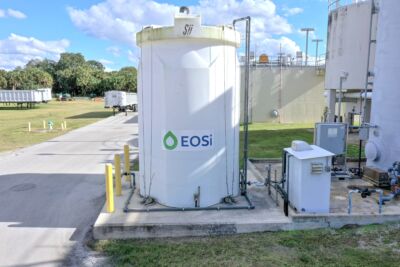Don’t Get Fooled – When It Comes to Carbon Sources, Is Cheaper Really Better?

Carbon Sources are not Created Equal
Crude Glycerin: Foregoing reliable quality for low cost is rarely a wise choice, especially when it comes to choosing your glycerin-based carbon sources and provider for biological nutrient removal (BNR). Why? Let’s start by comparing crude glycerin with highly refined carbon sources like EOSi’s MicroC®.
Typically, generic crude glycerin is produced as a biofuel byproduct and is shipped directly from biofuel manufacturers without extra refining and cleanup steps. Excess fatty substances and impurities, residues, and other included solid materials often cause clogging and residue problems with wastewater treatment processes, pumps, tanks, and handling equipment.
Low-quality crude glycerin quality also risks potential process downtime, triggering higher maintenance costs, equipment shutdowns, and staff overtime, risking “operational gaps” that violate plant permit requirements until remedied. Further, crude glycerin’s wide variances in quality control and chemical consistency can make optimizing carbon source feed rates a moving-target operational ordeal.

MicroC® Premium Carbon Sources: In contrast, highly refined glycerin-based carbon sources like EOSi’s MicroC 2000 undergo extensive manufacturing processes to remove excess levels of impurities and rigorous quality control that guarantee product consistency that prevents the clogged feed lines and pump system failures that can plague crude glycerin users. MicroC undergoes frequent sampling and testing by in-house EOSi testing labs at every step of production and delivery fulfillment, guaranteeing plant operators the highest quality consistency with every batch.
Crude glycerin may initially appear cheaper and more cost effective, but potential higher maintenance costs, operational downtime, and permit compliance risk can make it a case of “you might pay less, but you are also going to get less.” In fact, poor quality crude glycerin is the most cited reason why plant operators switch to MicroC, and treatment facilities that experience problems operating their biological nutrient removal processes with crude glycerin typically switch back to using MicroC within just a few months — and never return to using crude glycerin again.
“You’re on Your Own” vs. EOSi’s Robust Supply Network & Process Support
Biodiesel Refineries: Purchasing crude glycerin directly from biodiesel refineries can present unexpected operational pitfalls for wastewater treatment operators. Biodiesel refineries typically are focused solely on the business of supplying to large mass-market fuel customers rather than serving the exacting and stringent requirements for effective biological nutrient removal processes.
Unpredictable batch-to-batch variation in quality and consistency of crude glycerin, hit-and-miss supply availability, and unreliable point-to-point product delivery, can make crude glycerin single-sourced from biodiesel refineries an operational risk for wastewater plants that absolutely require a consistently dependable supply chain for permit compliance.
Expecting technical support or help troubleshooting your treatment processes? Biodiesel manufacturers are highly unlikely to provide experienced process expertise if glycerin usage problems arise, and industry expertise specific to optimizing biological nutrient removal operations is almost nonexistent. All you’re going to get from biodiesel manufacturers is the crude glycerin you receive from the tanker when it rolls up to your treatment plant.

EOSi: Unlike biodiesel refineries, EOSi specializes in manufacturing MicroC premium carbon sources specifically formulated for non-hazardous biological nutrient removal. A robust supply chain network of more than 20 EOSi manufacturing facilities across North America delivers MicroC directly to hundreds of wastewater treatment customers, ensuring reliable and dependable supply regardless of plant location or fluctuating market conditions.
Also unavailable from refinery suppliers are sophisticated dosing controls like EOSi’s Nitrack® automated system that helps wastewater treatment facilities streamline plant operations, reduce feed rate costs, and enhance process performance. Analyzing fluctuations in influent loading and accurately predicting the precise chemical dosing, EOSi’s Nitrack system dynamically optimizes the feed rate and minimizes unnecessary MicroC usage, boosting efficiencies by reducing feed costs by up to 30%.
EOSi’s most differentiating value according to most plant operators: you get EOSi’s expert in-house technical support when you buy MicroC products. Offering process expertise, industry experience, and immediate availability, EOSi’s process engineers are dedicated to helping customers use MicroC efficiently and cost-effectively to ensure permit compliance. A support call delivers instant assistance or even an onsite visit by an EOSi engineer if that’s what it takes — without ever receiving a bill.
EOSi remains the only company in the industry providing the essential combination of nonhazardous glycerin-based carbon sources, proven automation control systems optimizing the feed rate, and year-round engineering support to guarantee biological nutrient removal. The EOSi Promise: Every gallon of MicroC purchased delivers ten times its value through EOSi’s unwavering commitment to optimizing, enhancing, and maximizing performance.